Posts Tagged ‘plantation’
Six out of 10 are farm households in rural India
An agricultural year begins at the beginning of July and ends on the last day of June the following year. What we know now, thanks to the data provided by the Situation Assessment Survey of Agricultural Households, carried out by the National Sample Survey Office (NSSO) of the Ministry of Statistics and Programme Implementation (MoSPI) is that in the agricultural year 2012-13, rural India had an estimated total of 90.2 million agricultural households.
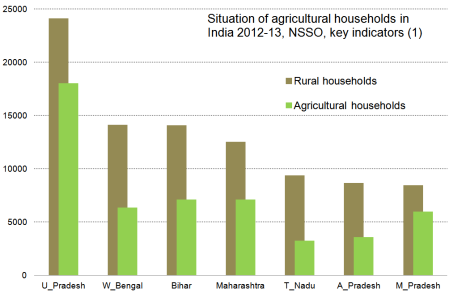 These agricultural households were about 57.8% of the total estimated rural households. Uttar Pradesh, with an estimate of 18.05 million agricultural households, accounted for about 20% of all agricultural households in the country. Among the major states, Rajasthan had the highest percentage of agricultural households (78.4%) among its rural households followed by Uttar Pradesh (74.8%) and Madhya Pradesh (70.8%). Kerala had the least percentage share of agricultural households (27.3%) in its rural households preceded by other southern states like Tamil Nadu (34.7%) and Andhra Pradesh (41.5%).
These agricultural households were about 57.8% of the total estimated rural households. Uttar Pradesh, with an estimate of 18.05 million agricultural households, accounted for about 20% of all agricultural households in the country. Among the major states, Rajasthan had the highest percentage of agricultural households (78.4%) among its rural households followed by Uttar Pradesh (74.8%) and Madhya Pradesh (70.8%). Kerala had the least percentage share of agricultural households (27.3%) in its rural households preceded by other southern states like Tamil Nadu (34.7%) and Andhra Pradesh (41.5%).
The NSSO’s previous such survey (the ‘Situation Assessment Survey of Farmers’) was conducted in 2003. The differences between the two, a decade apart, have been explained by the NSSO. First, such surveys aim to gather an assessment of the situation of our farmers and farming households.
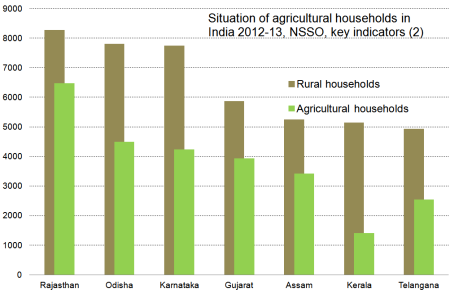 This assessment determines a standard of living as measured by consumer expenditure, income and productive assets, the indebtedness of farmers and farming households, farming practices and preferences, what resources are available to them, their awareness of technological developments and access to such technologies. The survey for the 2012-13 agricultural year also collected information on crop loss, crop insurance and awareness about the Minimum Support Price (MSP).
This assessment determines a standard of living as measured by consumer expenditure, income and productive assets, the indebtedness of farmers and farming households, farming practices and preferences, what resources are available to them, their awareness of technological developments and access to such technologies. The survey for the 2012-13 agricultural year also collected information on crop loss, crop insurance and awareness about the Minimum Support Price (MSP).
Second, the big difference between the two surveys is that the new survey has dropped the criterion of land possession for considering a household agricultural. “Recognising the fact that significant agricultural activity can be conducted without possessing any land, the definition of ‘farmer’ and ‘farmer household’ followed in NSS 59th Round was critically reviewed and the land possession as an eligibility criterion was dispensed with, replacing it with the concept of ‘agricultural production unit’ as one which produces field crops, horticultural crops, livestock and the products of any of the other specified agricultural activities,” is how the new survey (called the 70th Round) has explained its decision.
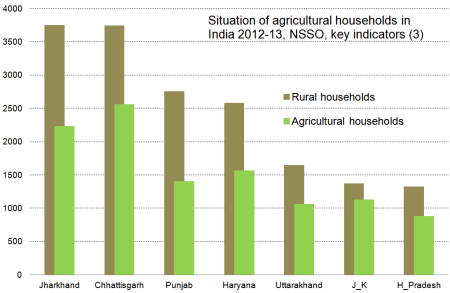 I find this puzzling and an aspect that needs careful probing. We know, from a close scrutiny of the Census 2011 data at the district level, that the number of people and households engaged in cultivation and farming has dropped when compared to the last census, in 2001, and the previous census, in 1991 (as a percentage of the rural working population but in several cases as absolute population numbers too).
I find this puzzling and an aspect that needs careful probing. We know, from a close scrutiny of the Census 2011 data at the district level, that the number of people and households engaged in cultivation and farming has dropped when compared to the last census, in 2001, and the previous census, in 1991 (as a percentage of the rural working population but in several cases as absolute population numbers too).
What reason could the NSSO have had to amend the definition it used ten years earlier? “With a view to keep the large number of households with insignificant agricultural activities out of survey coverage, it was decided to have a minimum value of agricultural produce for a household to qualify as an ‘agricultural production unit’,” the NSSO has explained. I cannot follow this reasoning. Are urban households which make negligible contributions to the local gross domestic product to be kept out of surveys that ought to assess their conditions – such as those with pensioners and informally employed people who get by on job work?
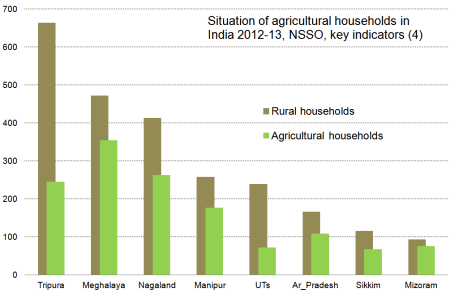 If this is the basis for exclusion, what qualifies a household for inclusion in the survey? The NSSO has considered average Monthly Household Consumer Expenditure (MHCE) for “home grown consumption of some specific items” and adopted a cut-off value amount of 3,000 rupees worth of annual agricultural produce. The activities which provided such value are given as “cultivation of field crops, horticultural crops, fodder crops, plantation, animal husbandry, poultry, fishery, piggery, bee-keeping, vermiculture, sericulture etc” with such a household “having at least one member self-employed in agriculture either in the principal status or in subsidiary status during last 365 days”.
If this is the basis for exclusion, what qualifies a household for inclusion in the survey? The NSSO has considered average Monthly Household Consumer Expenditure (MHCE) for “home grown consumption of some specific items” and adopted a cut-off value amount of 3,000 rupees worth of annual agricultural produce. The activities which provided such value are given as “cultivation of field crops, horticultural crops, fodder crops, plantation, animal husbandry, poultry, fishery, piggery, bee-keeping, vermiculture, sericulture etc” with such a household “having at least one member self-employed in agriculture either in the principal status or in subsidiary status during last 365 days”.
This cut-off value amount needs investigation. So does the idea of an ‘agricultural production unit’. And the NSSO for this survey has also excluded households which are entirely agricultural labour households, those households receiving income entirely from coastal fishing, as also the activity of “rural artisans and agricultural services”. Nonetheless, these data are important and useful for our understanding of the changes that have taken place in the food and agriculture domain.
The legacies of Pusa
 “In 1904, the Government of India began to recognise its responsibilities in the field of agricultural research. There was a large Government owned estate lylng unused in Pusa (Bihar) to which it was proposed to transfer the research station at Pemberandah. It had already become clear that the Indigo Industry could not be saved, and under these circumstances. However, before this scheme could mature it was superceded by a far more grandiose project under the initiative of the Viceroy Lord Curzon, for an All India Agricultural Service with Pusa as its Research Station under the Central Government and an Agricultural Department in each Province, with its research station and college at which district staff was to be trained.” This memory of more than a century ago comes via ‘Hugh Martin Leake: A Historical Memoir’, an article by N C Shah, in the Indian Journal of History of Science (2002).
“In 1904, the Government of India began to recognise its responsibilities in the field of agricultural research. There was a large Government owned estate lylng unused in Pusa (Bihar) to which it was proposed to transfer the research station at Pemberandah. It had already become clear that the Indigo Industry could not be saved, and under these circumstances. However, before this scheme could mature it was superceded by a far more grandiose project under the initiative of the Viceroy Lord Curzon, for an All India Agricultural Service with Pusa as its Research Station under the Central Government and an Agricultural Department in each Province, with its research station and college at which district staff was to be trained.” This memory of more than a century ago comes via ‘Hugh Martin Leake: A Historical Memoir’, an article by N C Shah, in the Indian Journal of History of Science (2002).
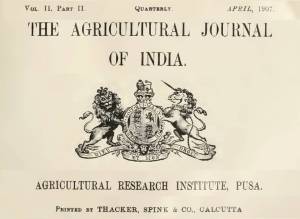 Even more interesting is the role of A O Hume in the establishment of the agricultural sciences centre that Pusa became. “What did Hume hope to do? He began by stressing how much Indian farmers already knew about their soils and climate, about plowing, about crop requirements, and about weeding. (‘Their wheat-fields would, in this respect,’ he said, ‘shame ninety-nine hundredths of those in Europe.’) Still, Hume argued, Indian agriculture had not changed for thousands of years; yields were not two-thirds of what they might be.” This comes from the very absorbing chapter, ‘Agricultural Development in British India’, by Bret Wallach, in ‘Modernisation and the Culture of Development’, Johns Hopkins University Press, 1996.
Even more interesting is the role of A O Hume in the establishment of the agricultural sciences centre that Pusa became. “What did Hume hope to do? He began by stressing how much Indian farmers already knew about their soils and climate, about plowing, about crop requirements, and about weeding. (‘Their wheat-fields would, in this respect,’ he said, ‘shame ninety-nine hundredths of those in Europe.’) Still, Hume argued, Indian agriculture had not changed for thousands of years; yields were not two-thirds of what they might be.” This comes from the very absorbing chapter, ‘Agricultural Development in British India’, by Bret Wallach, in ‘Modernisation and the Culture of Development’, Johns Hopkins University Press, 1996.
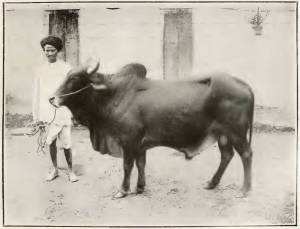 Wallach continues: ” ‘First and foremost unquestionably stands the increased provision of manure … the crying want of Indian agriculture’. That was Hume’s starting point, and he proposed to develop fuelwood plantations “in every village in the drier portions of the country” and thereby provide a substitute heating and cooking fuel so that manure could be returned to the land. Such plantations, he continues, were ‘a thing that is entirely in accord with the traditions of the country–a thing that the people would understand, appreciate, and, with a little judicious pressure, cooperate in’.”
Wallach continues: ” ‘First and foremost unquestionably stands the increased provision of manure … the crying want of Indian agriculture’. That was Hume’s starting point, and he proposed to develop fuelwood plantations “in every village in the drier portions of the country” and thereby provide a substitute heating and cooking fuel so that manure could be returned to the land. Such plantations, he continues, were ‘a thing that is entirely in accord with the traditions of the country–a thing that the people would understand, appreciate, and, with a little judicious pressure, cooperate in’.”
“Second on his list came an attack on rural indebtedness, chiefly by forbidding the use of land as security, a practice the British themselves had introduced. Hume denounced it as another of ‘the cruel blunders into which our narrowminded, though wholly benevolent, desire to reproduce England in India has led us.’ Third, Hume wanted government-run banks, at least until cooperative banks could be established.”
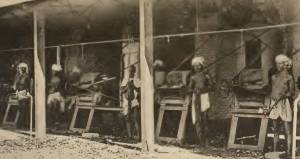 “Beyond these things, he noted, there were ‘innumerable other minor matters’ waiting for the department. They included the provision of seeds, the reclamation of salty soils, and plant breeding, a point on which he was astute enough to warn against selection merely for grain size: it was essential, he understood, to choose varieties suited to local physical and cultural conditions. He finished his list with a call for agricultural machinery, especially wind pumps, which he thought promising in a country where ‘gigantic wind-power (second only to the equally unutilised sun-ray power) is running to waste, utterly uncared for over the whole empire’.”
“Beyond these things, he noted, there were ‘innumerable other minor matters’ waiting for the department. They included the provision of seeds, the reclamation of salty soils, and plant breeding, a point on which he was astute enough to warn against selection merely for grain size: it was essential, he understood, to choose varieties suited to local physical and cultural conditions. He finished his list with a call for agricultural machinery, especially wind pumps, which he thought promising in a country where ‘gigantic wind-power (second only to the equally unutilised sun-ray power) is running to waste, utterly uncared for over the whole empire’.”